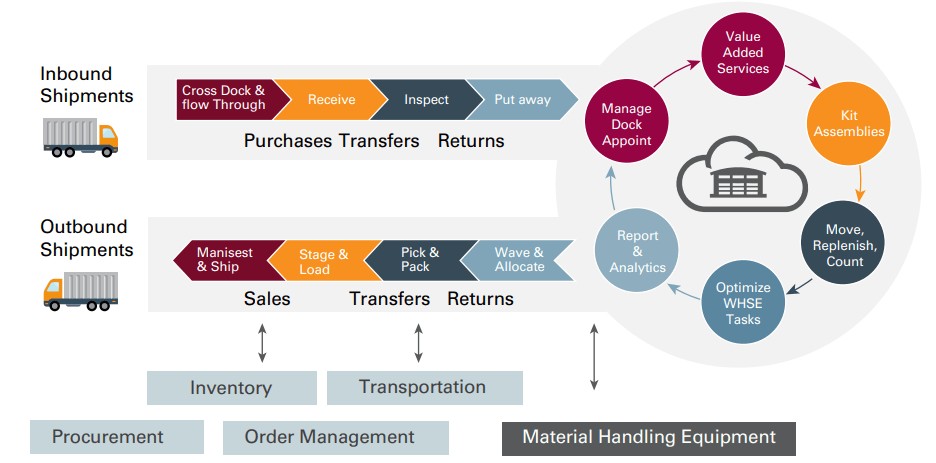The benefits of IoT-enabled Oracle warehouse management cloud are significant as it improves the visibility and traceability of goods throughout the supply chain. Some of the challenges faced by warehouses include space constraints, inefficient inventory tracking, improper space utilization, and a lack of visibility into data and processes. Modern warehouse managers need access to critical information in real-time to make smarter decisions. A smart connected warehouse that leverages the power of IoT, offers location-specific utilization information in real-time, eliminating manual tasks, and improving warehouse efficiency.
4 Features of Oracle Warehouse Management Cloud
- Warehouse Performance Monitoring – Get complete visibility into your processes to detect anomalies and prevent potential problems before they occur
- Predicting Warehouse Equipment Failure – Monitor equipment health and status to perform predictive maintenance before equipment failure occurs
- Worker Safety Monitoring – Continuously monitor worker safety and take preventive action when you detect potential risks
- Quality & Compliance Monitoring – Monitor product quality and take steps to prevent manipulation. Ensure proper compliance with state and federal regulations.
Modern Smart Connected Warehouse (Image Source: Oracle)
Benefits of Oracle Warehouse Management Cloud
It provides complete inventory management from the manufacturing source to the end user, allowing you to source and fulfill orders from anywhere. Warehouse managers can use mobile devices to view real-time analytics and get complete visibility into inventory across distribution centers. They can also analyze labor productivity by comparing goals to actual performance. The solution combines the flexibility and savings of the cloud with best-of-breed functionality while giving businesses a complete view of their inventory without the high maintenance costs and upgrade challenges of traditional solutions.
Optimize Inventory Management
Oracle Warehouse Management Cloud can be used to manage materials and provide total inventory accountability and visibility, optimizing and automating warehouse operations with multi-channel fulfillment needs. The solution enables end-to-end inventory management and productivity improvements across the supply chain.
Increase Scalability
Integrating your current warehouse control systems with Oracle’s warehouse management cloud helps you create automated facilities. This improves efficiency, allows you to scale your warehouse operations quickly, and gives you the ability to serve customers faster.
Improve Workforce Management
Oracle Warehouse Management Cloud provides warehouse managers with greater visibility into their operations and workforce to help reduce labor inefficiencies, raise overall performance, and improve accuracy. It includes KPIs that manage and track workforce performance based on quantifiable goals.
Leverage Supply Chain Analytics and Dashboards
Oracle Warehouse Management Cloud offers powerful analytics and dashboards that enable real-time analysis, reporting, and alerting. You can build your own dashboards and reports, measuring KPIs for multiple warehouses and sourcing locations to enables real-time analysis of location utilization, and inventory etc.
Real-Time Insights from Connected Assets
Oracle IoT Asset Monitoring Cloud improves profitability through automated monitoring and alerting of assets. Businesses can gain real-time visibility into asset health and utilization and predict future events. Improve Worker Safety Oracle IoT Connected Worker Cloud helps ensure worker health and safety, achieve better regulatory compliance, and gain real-time visibility into worker health, location, and work environment.
Potential Outcome of Oracle Warehouse Management Cloud
Reduce Warehouse Operating Costs
- 15% – 35% improvement in labor productivity
- 10% – 25% reduction in labor costs
- 10% – 20% increase in equipment usage
- 10% – 25% increase in storage capacity
- 5% – 10% reduction in expedited shipping costs
- 15% – 45% reduction in IT-related costs
Reduce Warehouse Inventory Costs
- 15% – 30% reduction in safety stock
- 15% – 25% reduction in missing inventory
- 15% – 30% reduction in damaged material
- 15% – 45% reduction in expired material
Increase Revenues
- 0.5% – 2.5% increase in revenues
- 10% – 25% increase in on-time and full shipments
- 15% – 35% improvement in customer satisfaction

